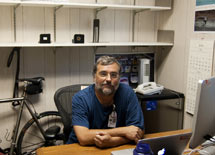
Handy Links
SLAC News Center
SLAC Today
- Subscribe
- Archives: Feb 2006-May 20, 2011
- Archives: May 23, 2011 and later
- Submit Feedback or Story Ideas
- About SLAC Today
SLAC News
Lab News
- Interactions
- Lightsources.org
- ILC NewsLine
- Int'l Science Grid This Week
- Fermilab Today
- Berkeley Lab News
- @brookhaven TODAY
- DOE Pulse
- CERN Courier
- DESY inForm
- US / LHC
SLAC Links
- Emergency
- Safety
- Policy Repository
- Site Entry Form

- Site Maps
- M & O Review
- Computing Status & Calendar
- SLAC Colloquium
- SLACspeak
- SLACspace
- SLAC Logo
- Café Menu
- Flea Market
- Web E-mail
- Marguerite Shuttle
- Discount Commuter Passes
-
Award Reporting Form
- SPIRES
- SciDoc
- Activity Groups
- Library
Stanford
Around the Bay
People: Bill White Makes Lasers Light Up
With the coming dedication of the Linac Coherent Light Source, the word "laser" is generally associated with "X-ray" in the minds of people at SLAC, and for good reason. But there are other lasers here—many other lasers. Lasers for researchers using SLAC resources, lasers for SLAC research (for example, the Next Linear Collider Test Accelerator) and the injection laser that enables the LCLS to generate its coherent X-ray laser beam. Bill White and his team of self-proclaimed "laser monkeys" in the Laser Science Department try to support all of them.
When White arrived at SLAC five years ago from Lawrence Livermore National Laboratory by way of private industry, the LCLS project was the big draw. Sasha Gilevich and Dave Dowell (both then with the LCLS project) were busy designing the injector laser system, and White wanted to get in on the action.
"I came here because the LCLS was a very exciting project," White said. "I knew a lot of the people involved and I wanted to work with them."
White got more action than he bargained for. "I was hired to build a laser group," with, as he put it, "enough critical mass to maintain lasers at both ends" of the LCLS. Now there are so many lasers at SLAC that White almost can't keep count.
In addition to LCLS lasers, White supports visiting researchers, ensuring they have the lasers they need. "Eighty to ninety percent of the experiments at LCLS rely on optical lasers to either 'pump' or excite the material, which is then probed by X-rays," White said, "or the X-rays pump the material and the optical lasers probe it." And while the Laser Science Department is officially under the LCLS Science, Research and Development Division, the department attempts to support laser science across the lab.
Since the LCLS is just ramping up, more lasers are in White's future. "We are adding lasers at a pretty fast rate," he said. "I expect to add five systems in the next year, with each system composed of five to 10 lasers."
Good thing White likes lasers—or rather, White likes gadgets and lasers are great gadgets. Originally from the Dallas-Fort Worth area, he first began tweaking lasers as a graduate student at Texas A&M University. His optics and atomic physics experiments required lasers, and the lasers generally required customization. White became a laser guy, first by necessity, then, as his inner gadget lover took over, by choice. "One thing about laser guys is that they're never finished with a laser," White said. "They can tweak it forever. There's always some way to improve it."
However, LCLS users—not to mention White's bosses—expect the lasers to be stable for use in doing science.
White's experience in corporate America, with its similar mindset, came to the rescue. "One thing about building up a laser group is you have to build up the discipline to actually turn on the lasers," he said wryly. He employs a foolproof method to keep his own laser monkeys in line. "What I do these days instead of tweaking lasers is threaten to tweak them." That's usually enough of a threat for White to get results.
White is fond of other gadgets as well, but since LCLS became operational his time is spent on SLAC lasers. His bike has been sitting in his office unused for so long the tires have deflated. There's little prospect that he will add any new photos to the images of Alaskan wildlife adorning his wall any time soon. Yet along with his love of gadgets, one thing White hasn't lost in the press of work is his dry sense of humor. A red, white and blue placard hangs on his office door, obviously snitched from the campaign of a certain ex-mayor of Houston now running for Governor: "Bill White for Texas."
Bill White for SLAC. Texas can take care of itself, but we have a lot of lasers to tweak.
—Lori Ann White
SLAC Today, July 21, 2010
